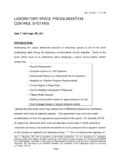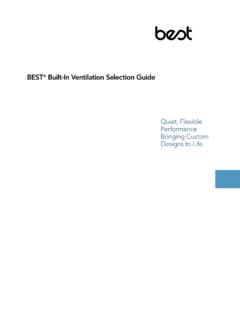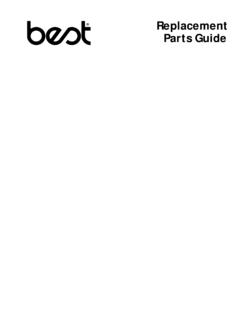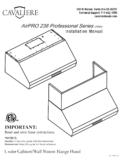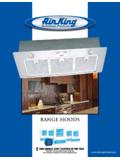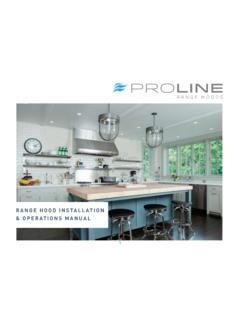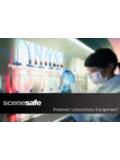Transcription of Guide Specification for Laboratory Fume Hood Commissioning
1 Guide SpecificationforLaboratory fume hood Commissioning3 February, 1997 Application notes:This Specification is intended to be used by qualified, experienced engineers andindustrial hygienists as a Guide for specifying the Commissioning or testing oflaboratory fume to it will be required to customize it to your particular application,project or facility. Simply cutting and pasting it into another document isinsufficient. If you are unfamiliar with the ASHRAE 110 method then youshould retain a Laboratory consultant for assistance. Consult the followingWWW page for more information: processing files of this document may be downloaded in several differentformats from the page above using most web embedded in this Guide Specification are enclosed in [brackets].
2 All references to the ANSI/ASHRAE 110-1995 Method of Testing Performanceof Laboratory fume Hoods shall be abbreviated as ASHRAE 110 and questions about this Specification should be addressed to:Dale T. Hitchings, PE, CIHH itchings Associates, PC,by e-mail at: by calling: following fume hoods shall be commissioned using the method outlinedherein:[Insert list of fume hoods to be commissioned here.] Contractor fume hood Commissioning contractor shall have a Certified IndustrialHygienist (CIH) on staff and the testing technician shall either be certified toperform the ASHRAE 110 test by the International Laboratory Safety Institute[see note below] or shall demonstrate competency in this are by proving thatthey perform at least 100 of these tests per year and can provide referencesacceptable to the.
3 At this time, a certification organization is being formed to train, test, certify, and maintainthe certifications of consultants and contractors who do Laboratory design and fume hood testingand Commissioning . The organization is called the International Laboratory Safety Institute. Assoon as they are operating their training and certification programs, a phone number and addresswill be added. Until then, we suggest the following three firms who are properly qualified to doASHRAE 110 testing, interpret the results and make recommendations for improving fume hoodperformance.
4 They are:Hitchings Associates, PC5320 W. 79th , IN 46268 Phone: 317-872-6600(Dale Hitchings is an expert in Laboratory ventilation and has performed hundreds of ASHRAE tests and has performed significant research on applying and improving the method.)Exposure Control Technologies120 Loch Haven Ln., Carey, NC 27511 Phone: 919-859-6572(Tom Smith, President of ECT has performed more ASHRAE 110 tests than anyone on the planetand pioneered many of the automated data collection techniques outlined herein)Knutson Ventilation Consulting, W. 60th , MN 55410 Phone: 612-928-0195(Dr.)
5 Knutson co-developed the ASHRAE 110 method as part of an ASHRAE research projectback in the late 1970 s and is imminently qualified.)] and Commissioning contractor shall be properly equipped to perform this testingincluding, but not limited to: the equipment specified in section 4 of theASHRAE 110 standard plus an automated data acquisition system capable ofreading data from an analog velocity transducer and the tracer gas detector andproducing graphical instruments used shall have been calibrated within the last year or within thetime period specified by the instrument calibration gases used shall have certificates of test conditions outlined in section 5 of the ASHRAE standard shall Procedures for All fume System Stability test shall be performed at least once on all manifolded exhaustsystems
6 To which fume hoods which are to be commissioned the velocity transducer into the exhaust duct (preferred) orinsert it into the middle baffle slot of the hood normal to the back ofthe the probe window parallel to the duct centerline if inserted intothe duct or vertical if it is inserted into the baffle velocity readings to determine if the velocity is in the range ofthe transducer. If not, change the range of the transducer or relocate itto another excessive (high frequency) turbulence is experienced, relocate thetransducer farther downstream from the nearest velocity acquisition and accumulate velocity data for the standard deviation of the velocity data and normalize bythe mean to get the coefficient of variation (COV).
7 The velocity plot graphically and determine if systeminstability exists. Instability is normally manifested by large velocityvariations (>10% above and below the mean) with a relatively lowfrequency (>10 seconds). The variations may be random or instability exists, investigate and correct the problem and repeat thestability test before proceeding with further the final COV data and the plot of the velocity on the Visualization Challenge (Low-Volume Smoke Test) test is to be performed per section of the ASHRAE observations shall be classified using the following criteria andrecorded on the test : Smoke observed escaping from the : Reverse flow of smoke near opening.
8 Lazy flowinto opening along boundary. Observed potential : Some reverse flow, not necessarily at the visible : No reverse flows. Active flowstreams into hoodaround smoke escapes from the hood during this test it indicates a grossleak and testing shall be terminated until the cause of the leakage isdetermined and Smoke Visualization Challenge (High-Volume Smoke Test) test is to be performed per section of the ASHRAE observations shall be classified using the following criteria andrecorded on the test : Smoke observed escaping from the : Reverse flow of smoke near opening.
9 Slow captureand clearance. Observed potential for : Some reverse flow, not necessarily at the turbulent vortex in hood . All smoke captured andcleared readily. No visible : Good capture and quick clearance. Limited hoodroll vortex. No reverse flows. No visible smoke escapes from the hood during this test it indicates a grossleak and testing shall be terminated until the cause of the leakage isdetermined and Velocity velocity testing shall be performed per section of theASHRAE 110 standard with the following instrument shall be a velocity transducer with acontinuous analog output interfaced to a data acquisitionsystem and a computer with software capable of reading.
10 Storing and displaying graphically the velocity data shall be taken at a frequency not less thanthe response time of the instrument and not greater thanonce per data shall be taken for a minimum of 30 secondsat each traverse average, minimum, maximum, standard deviation,and grid coordinates for each traverse point shall becalculated and recorded on the test average face velocity shall be calculated from thedata above and recorded on the test Turbulence shall be calculated by averaging thestandard deviations of each traverse point andnormalizing by the mean face velocity.
